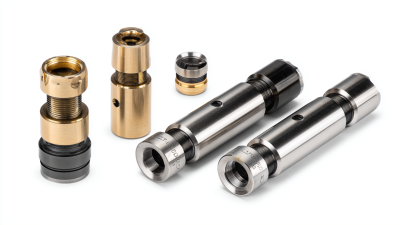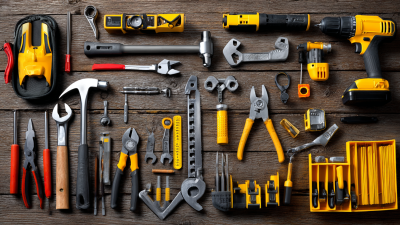In the realm of modern manufacturing, the techniques employed in cutting milling play a crucial role in determining the efficiency and quality of production processes. As industries strive for precision and versatility, understanding the fundamental principles behind cutting milling becomes essential for engineers, machinists, and manufacturers alike. This introductory segment delves into the intricacies of cutting milling, highlighting its significance in various machining applications and the evolution of technologies that enhance its capabilities.
With the relentless advancement of manufacturing technologies, cutting milling techniques have risen to prominence due to their ability to produce intricate designs and meet stringent tolerances. These methods not only improve productivity but also contribute to cost-effectiveness in manufacturing environments. As we explore the "Top 5" cutting milling techniques that are shaping the industry today, we will uncover their applications, advantages, and the transformative impact they have on the manufacturing landscape. By grasping these essential techniques, professionals can optimize their operations, driving innovation and maintaining competitiveness in an ever-evolving market.

Cutting and milling techniques are fundamental components of modern manufacturing, enabling the production of precise and intricate parts across various industrial sectors. Key principles include the understanding of tool dynamics, material properties, and operational variables that influence performance. For instance, high-speed machining has emerged as a vital factor, requiring meticulous attention to the cutting tool, spindle, and machine dynamics to enhance efficiency and precision, particularly in aerospace applications.
Additionally, novel approaches like electrochemical grinding and advancements in CNC machining technology are gaining traction, further broadening the capabilities of traditional methods. The integration of ultrafast lasers and MQL-assisted machining offers exciting possibilities for micromachining and the processing of superalloys, enhancing sustainability and precision. As manufacturing continues to evolve, the principles guiding cutting and milling will remain essential in addressing the growing demand for high-quality, efficient production processes tailored to intricate designs and advanced materials.
In the realm of modern manufacturing, the choice of cutting tools and their applications plays a critical role in determining the efficiency and quality of production processes. Cutting tools such as indexable milling cutters have become increasingly popular due to their versatility and effectiveness in various machining operations. These tools are designed to facilitate both roughing and finishing processes, allowing manufacturers to achieve precise tolerances and surface finishes. The evolution of indexable insert technology has enabled these tools to adapt to diverse materials and complex geometries, further enhancing their applicability in different manufacturing scenarios.
The global market for metal cutting tools is expected to see substantial growth, driven by advancements in CNC and multi-axis machining technologies. These innovations have transitioned metal cutting tools from standalone equipment to digitally integrated systems, significantly improving machining accuracy and production capabilities. As industries continue to demand higher precision and efficiency, there is an increasing emphasis on optimizing tooling strategies and utilizing application-specific tools. This shift not only helps in reducing production costs but also improves overall productivity, making modern cutting tools indispensable in the manufacturing landscape.
| Cutting Tool Type | Material | Application | Advantages |
|---|---|---|---|
| End Mill | High-Speed Steel (HSS) | General milling operations | Cost-effective and versatile |
| Ball Nose Cutter | Carbide | 3D contouring | Excellent for complex shapes |
| Face Mill | Insert tooling (Carbide) | Face milling large surfaces | High feed rates and productivity |
| Slab Mill | HSS or Carbide | Machining flat surfaces | Efficient for large surface areas |
| T-slot Cutter | Carbide | Cutting T-slots in workpieces | Essential for fixture setups |
The integration of CNC (Computer Numerical Control) technology has revolutionized milling precision in modern manufacturing. CNC systems enable manufacturers to achieve unparalleled accuracy and repeatability, making them essential for producing intricate components across various industries. Recent advancements in CNC machining technology, particularly in high-precision applications, have led to significant improvements in efficiency and productivity. The capacity to program complex geometries and embrace automated operations has allowed manufacturers to increase output while maintaining strict quality control.
Moreover, companies are continually investing in state-of-the-art CNC machinery to enhance their manufacturing processes. With the precision turned product manufacturing market expected to reach substantial valuations in the coming years, the role of CNC technology becomes even more crucial. Innovations in CNC systems facilitate not only the production of high-quality parts but also enable manufacturers to respond swiftly to market demands. This agility is particularly critical as industries seek to optimize their workflows and minimize lead times in an increasingly competitive landscape.
Cutting efficiency and tool longevity are critical factors in modern manufacturing techniques, particularly when dealing with advanced materials such as the LM25 aluminum alloy reinforced with vanadium carbide composite. Recent studies utilizing analytical modeling and deep learning have revealed significant insights into the machinability of this composite, emphasizing the importance of optimizing machining parameters to enhance cutting efficiency. The right tooling and cutting conditions can make a dramatic difference in wear rates and overall productivity.
**Tip:** Always consider the properties of the materials being machined. For instance, when working with heat-resistant superalloys or advanced composites, selecting the correct cutting tool and lubrication strategy is essential to prolong tool life and maintain cutting performance.
Furthermore, optimizing micro tool geometry for specialized applications, like ballpoint pen production, demonstrates the intricate balance between design and functionality. The application of finite element simulation and orthogonal experiments can lead to innovations that reduce tool wear and prevent failures during the manufacturing process.
**Tip:** Regularly monitor and analyze cutting forces and wear patterns. This data will help you refine your machining processes over time, thereby ensuring that you maximize tool longevity and operational efficiency.
This chart illustrates the cutting efficiency of various milling tool materials in modern manufacturing. The data indicates that carbide tools offer the highest cutting efficiency, followed closely by cobalt tools, demonstrating their effectiveness in machining applications.
Safety and maintenance are paramount in milling operations, as they directly impact both the efficiency of production and the wellbeing of personnel. One of the best practices for ensuring safety is to conduct regular training sessions for operators on machine handling. This includes familiarizing them with the specific features of the milling machinery, emergency shutdown procedures, and the appropriate use of personal protective equipment (PPE). Additionally, routine inspections of the equipment are essential. Checking for worn tools, loose components, and ensuring proper lubrication can prevent accidents and prolong the lifespan of the machines.
Maintenance practices should also be documented meticulously. Keeping a log of all maintenance work can help identify patterns or recurring issues that need to be addressed. Implementing a preventive maintenance schedule ensures that potential problems are rectified before they lead to significant downtime or safety hazards. Moreover, keeping the work environment clean and organized not only aids in maintaining the equipment but also enhances overall safety by minimizing the risk of slips, trips, and falls. Regular audits of safety protocols and adherence to safety regulations are crucial to cultivate a culture of safety in milling operations.






Contact
KYOCERA SGS Precision Tools, Inc.
(330) 686-5700
150 Marc Drive
Cuyahoga Falls, OH 44223
Products
Resources